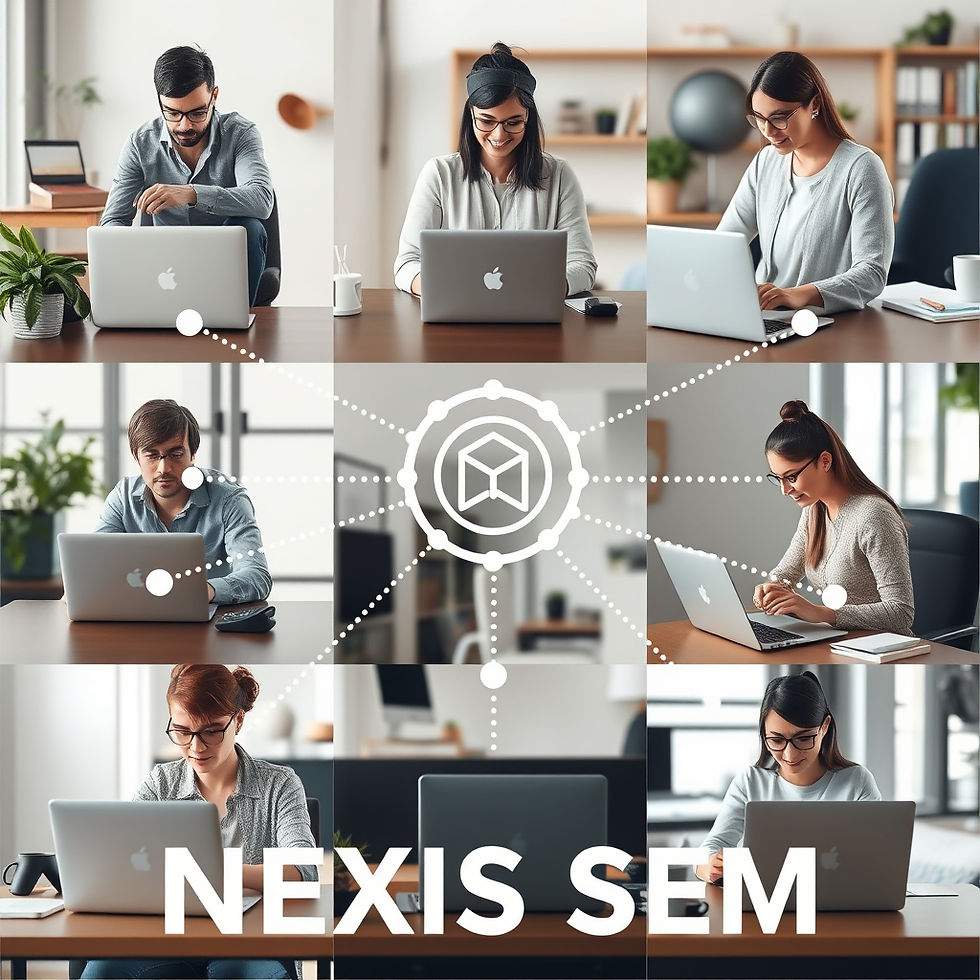Mastering Multitasking in a Hyper-Connected World: Efficiency Without Burnout
- Saeed Ebadzadeh
- Aug 4
- 4 min read

Hello Nexis-SEM community!
In our hyper-connected digital world, the ability to "multitask" is often seen as a badge of honor, a symbol of productivity. We juggle emails, instant messages, phone calls, and complex projects, all while trying to stay on top of social media and news feeds. However, this constant switching often leads to a subtle but significant problem: we feel incredibly busy, yet we accomplish less, make more mistakes, and ultimately inch closer to burnout. The reality is, true multitasking – doing multiple attention-demanding tasks simultaneously – is largely a myth. Our brains aren't wired for it.
As an experienced professional in sales and office management, I've learned that true efficiency isn't about doing more things at once. It's about strategic task management, deep focus, and cultivating digital habits that support productivity without leading to exhaustion. At Nexis-SEM, we're dedicated to empowering you with the practical skills to navigate the digital world effectively and achieve efficiency without burnout.
The Multitasking Myth: Why True Simultaneous Work Fails
Neuroscience reveals that our brains are not designed for true multitasking when it comes to complex cognitive tasks. What we perceive as multitasking is actually rapid context switching – quickly shifting our attention from one task to another. Each switch comes with a "switching cost":
Reduced Focus: It takes time for your brain to reorient and regain deep focus on a new task, leading to wasted minutes and shallower engagement.
Increased Errors: The constant mental gymnastics raise the likelihood of mistakes and oversights.
Lower Quality Work: When your attention is fragmented, the quality of your output suffers.
Mental Fatigue and Stress: The effort required for constant switching is draining, contributing significantly to stress and cognitive overload, paving the way for burnout.
You might feel productive because you're constantly "doing," but the actual output and quality are often diminished.
The Reality: Strategic Task Switching for Real Efficiency
Since true multitasking is inefficient, the goal isn't to eliminate task switching entirely (which is often impossible in modern roles) but to make it strategic and efficient. This means optimizing how and when you switch tasks to minimize cognitive costs and maximize productivity.
Strategies for "Smart Multitasking" and Sustainable Efficiency
Here's how to master task management and achieve efficiency without burnout in a hyper-connected world:
Batch Similar Tasks:
Action: Group similar activities together. For instance, check and respond to emails only at specific times (e.g., 9 AM, 1 PM, 4 PM). Make all necessary phone calls in one block. Process all administrative paperwork at once.
Benefit: Reduces context switching, allowing your brain to stay in one "mode" for longer, improving speed and accuracy.
Implement Time Blocking & Deep Work Sessions:
Action: Dedicate specific, uninterrupted blocks of time (e.g., 60-90 minutes) for your most important, complex, or high-impact tasks. During these "deep work" sessions, eliminate all distractions.
Benefit: Cultivates profound focus, leading to higher quality work and significant progress on key objectives.
Prioritization Techniques (e.g., Eisenhower Matrix):
Action: Categorize tasks by urgency and importance (Urgent/Important; Important/Not Urgent; Urgent/Not Important; Not Urgent/Not Important). Focus your energy on the "Important" tasks first.
Benefit: Ensures you're working on what truly matters, preventing reactive responses to less critical tasks.
Minimize Digital Distractions Aggressively:
Action: Turn off all non-essential notifications (email, social media, news apps) during work hours. Close irrelevant browser tabs. Use "Do Not Disturb" modes on your devices.
Benefit: Protects your precious attention span from constant interruptions, fostering better concentration.
Apply the "Two-Minute Rule":
Action: If a task takes less than two minutes to complete, do it immediately. (e.g., quick reply, filing a document, a short call).
Benefit: Prevents small tasks from piling up and becoming overwhelming, clearing your mental space.
Strategic Breaks & Resetting:
Action: Don't work continuously. Take short, intentional breaks every hour or two. Step away from your screen, stretch, grab water, or take a short walk.
Benefit: Allows your brain to rest and re-energize, improving overall sustained focus and preventing fatigue.
Leverage Delegation and Automation:
Action: Identify tasks that can be delegated to team members or automated using technology (e.g., scheduling tools, recurring payment setups, CRM automation). Familiarity with platforms like Microsoft Office Suite and other operational platforms can greatly assist here.
Benefit: Frees up your time for higher-value activities that require your unique expertise.
Practice Single-Tasking for Critical Work:
Action: For tasks that demand your absolute best (strategic planning, client negotiations, complex problem-solving), dedicate your entire, undivided attention.
Benefit: Ensures maximum quality and efficiency where it matters most, reducing errors and stress.
Preventing Burnout in a Hyper-Connected World
Beyond managing tasks, preventing burnout requires proactive self-care and boundary setting:
Set Clear Boundaries: Define your work hours and stick to them. Avoid checking emails late at night or on weekends unless absolutely critical.
Digital Detox Periods: Incorporate regular periods of disconnecting (as discussed in our previous article on Digital Minimalism) – even short breaks can make a difference.
Prioritize Sleep, Nutrition, and Exercise: These foundational elements are non-negotiable for sustained energy and mental clarity.
Learn to Say "No": Protect your time and energy by declining commitments that don't align with your priorities or capacity.
Regular Reflection: Periodically assess your productivity and energy levels. What tasks or habits are draining you? What's genuinely moving you forward? Adjust accordingly.
Conclusion
In a world that constantly pushes us towards perceived multitasking, true productivity and well-being come from strategic task management and focused attention. By understanding the limitations of our brains and intentionally designing our work habits, you can transcend the "busy trap" and achieve genuine efficiency without burnout. Embrace these strategies, cultivate self-awareness, and reclaim control over your valuable time and energy in this hyper-connected world.
What are your go-to strategies for staying efficient and avoiding burnout? Share your insights and experiences in the comments below!
Warmly,
Saeed Ebadzadeh Mosadegh









Comments